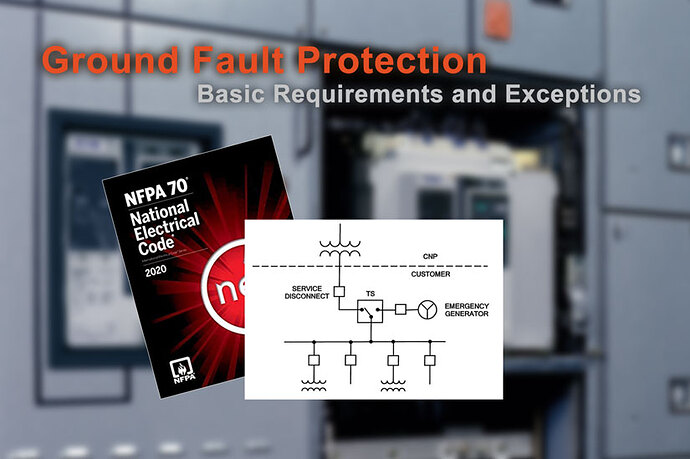The National Electrical Code (or NFPA 70) is one of the most important standards for the safe installation of electrical wiring and equipment in the United States. Its purpose is to safeguard persons and property from hazards arising from the use of electricity.
“Ground fault” is a term defined in NFPA 70 as: “An unintentional, electrically conductive connection between an ungrounded conductor of an electrical circuit and the normally non-current-carrying conductors, metallic enclosures, metallic raceways, metallic equipment, or earth.” In simple terms, its a short circuit to ground that occurs due to some internal equipment failure or other external influence.
NEC Ground Fault Requirements
Typically, a ground fault will result in catastrophic damage (such as fire or explosion) if not eliminated quickly. There are several important articles in the National Electrical Code (NFPA 70) that address ground fault protection to help safeguard equipment from the effect of such events.
Article 230.95 (Services) requires solidly grounded Wye electrical services with main disconnecting means rated at 1,000A or more to be provided with Ground-fault protection of equipment (GFPE) where the voltage is more than 150V to ground but does not exceed 600V phase-to-phase. The setting of the GFPE must not be greater than 1,200A and the maximum time delay before operation shall not exceed one second (60 cycles) for ground-fault currents of 3,000A or greater.
Article 215.10 (Feeders) specifies that each feeder disconnect rated 1000 amperes or more and installed on solidly grounded wye electrical systems of more than 150 volts to ground, but not exceeding 600 volts phase-to-phase, shall be provided with ground-fault protection of equipment.
Article 240.13 (Overcurrent Protection) describes ground-fault protection of equipment shall be provided in accordance with the provisions of 230.95 (Services) for solidly grounded wye electrical systems of more than 150 volts to ground but not exceeding 1000 volts phase-to-phase for each individual device used as a building or structure main disconnecting means rated 1000 amperes or more.
Article 517.17 (Healthcare Facilities) states that if ground fault protection is placed on the main service of a health care facility, ground fault relays must also be placed on the next level of feeders. The separation between ground fault relay time bands for any feeder and main ground fault relay must be at least six cycles in order to achieve coordination between these two ground fault relays. In health care facilities where no ground fault relay is placed on the main, no ground fault relays are required on the feeders.
When are ground fault relays NOT required?
There are several exceptions within NFPA 70 which do not require systems to be equipped with ground fault protection including:
-
Continuous industrial process where a non-orderly shut down would increase hazards. (See 215.10)
-
All services or feeders where the disconnect is less than 1000 amps.
-
All 208Y/120 Volt, 3ø, 4W (wye) services or feeders.
-
All single-phase services or feeders including 240/120 Volt.
-
High or medium voltage services or feeders. (See 240.13 and 215.10 for feeder requirements)
-
All services or feeders on delta systems (grounded or ungrounded) such as 240 Volt, 3ø, 3W delta, or 240 Volt, 3ø, 4W delta with midpoint tap.
-
Service with six disconnects or less (See 230.71) where each disconnect is less than 1000 amps. A 4000A service could be split into 5 – 800A switches.
-
Resistance or impedance grounded systems.
-
Fire Pumps (See 695.6(G))
-
For feeders where Ground Fault Protection is provided on the service (does not apply to Health Care Facilities. See 517.17.)
-
If temporary feeder conductors are used to connect a generator to a facility for repair, maintenance, or emergencies, ground-fault protection of equipment shall not be required. Temporary feeders without ground-fault protection shall be permitted for the time period necessary but shall not exceed 90 days. (See 215.10 Exceptions)
-
The alternate source for legally required standby systems shall not be required to have ground fault protection of equipment with automatic disconnecting means (See 701.26).
-
The alternate source for emergency systems shall not be required to have ground fault protection of equipment with automatic disconnecting means. However, ground fault indication of the emergency source shall be provided if ground fault protection of equipment with automatic disconnecting means is not provided. (See 700.27)

